英文介绍中医
Chinese Medicine

Traditional Chinese Medicine (TCM,中国传统医学) is also well-known as Chinese Medicine(中医,zhōngyī). Based on the theory of yin-yang(阴阳)and five elements(五行), it also absorbs experience that how ancient Chinese people fight with disease and then develops into a broad range of medical care ways, including various forms of Chinese Herbal Medicine(草药cǎoyào), Cupping(拔火罐báhuǒguàn), GuaSha(刮痧guāshā),Acupuncture(针灸zhēnjiǔ),Moxibustion(艾灸àijiǔ), Massage(推拿tuīná按摩ànmó), pediluvium (足浴), Qigong(气功qìgōng)and Dietary therapy(食疗shíliáo).Traditional Chinese Medicine (TCM) has a huge influence throughout East Asia since ancient time and now also in the western world. Generally speaking, Traditional Chinese Medicine (TCM) can be divided into two main parts: Han medicine and ethnomedicine. The former one refers to a medicinal science which is created by the Han People; The latter one includes Zang Medicine(藏医Tibetan Medicine), Meng Medicine(蒙医Mongolian Medicine), Miao Medicine(苗医) and other ethnic medicine. However, when we mention Traditional Chinese Medicine or Chinese Medicine, most of the time, we just mean Han medicine.Traditional Chinese Medicine treats human body as an entity of qi(气), shape(形) and spirit(神). Then through four diagnostic methods to search for the cause of disease and analyze the change of the zang-fu, jingluo,qi,blood(血) and jinye, after that, a disease name will come out and suitable medical care way will be adopted.Important Terms and Concepts in Traditional Chinese Medicineyin-yang: 阴阳,yīnyáng, the concepts of yin and yang came from ancient Chinese people’s views of nature. In old times, they found many nature phenomenon in an against or conjoint relationship, for instance, heaven and earth, the sun and the moon, day and night, male and female,inside and outside, downward and upward, etc, so they drew a conclusion in a philosophy way----yin and yang, which was mentioned in Yi Zhuan and Dao De Jing of Laozi in the spring and autumn period and infiltrated nearly every aspect of Chinese traditional culture. Hence, yin and yang also extends to the various body functions: exterior and interior, cold and heat, vacuity and excess. The balance of yin and yang is a symbol of health.five phasesfive phases or five elements: 五行, wǔ xíng, is a view of matter in ancient China and used very often in Chinese philosophy ,Chinese medicine and divination. In old times, Chinese people thought nature was formed by five elements: metal, wood, water, fire and earth. With ups and downs of five elements, nature changed and people’s fates also were influenced. Talking about Chinese medicine, five elements indicates different organs. Because of the mutual generation and restriction relation between five elements, Chinese doctors believed one organ’s pathology would have great effect on other organs.Four Diagnostic Methods(四诊)----four must steps in Chinese MedicineWang: 望,wàng, to observe a patient’s growth, complexi on, coating on the tongue, expression and so on;Wen: 闻,wén, to listen to a patient’s voice, cough, breath and smell his halitosis and body odor;Wen: 问,wèn, to ask a patient about his symptom and medical history;Qie: 切,qiē, to feel a patient’s pulse and touch his abdomen to see whether there is a lump or not.zang-fu: 脏腑,zàngfǔ, a generic term for the vital organs of a human body in Chinese Medicine, they are different from anatomical organs. Ancient Chinese people divide internal organs into Fivezang(五脏)和Sixfu(六腑). Fivezang includes Heart, liver, Spleen, Lung and Kidney which have a function to store qi and jinye. While Sixfu refers to Gallbladder, Stomach, Large Intestine, Small Intestine, Urinary Bladder and Sanjiao which have essential functions consisting of transmitting and digesting substances like waste, food, etc.jingluo: 经络, jīng-luò, jīng are the meridians and luò are subsidiary channels. In Chinese Medicine, jīng-luò is not only to connect the interior of the body to the surface but also the channels for transporting qi and xue. The study of jīng-luò is a significant foundation for acupuncture and massage. According to the difference of size and shade, TCM identifies twelve “regular"(十二经脉), eight "extraordinary" meridians(奇经八脉) and fifteencollaterals(十五络脉).qi: 气,Qì, is a very common concept in Chinese philosophy, Chinese Fengshui, Taoism and Chinese Medicine. It is believed to be the basic substance to form a body and the most elementary energy for maintaining vital movement.TCM uses different names for identifying qi that runs inside of the blood vessels or circulates in the meridians. And the most important qi is “principal qi”(元气yuánqì )or “true qi”(真气,zhēnqì) that held by zangfu.jinye: 津液,jīnyè, bodily fluids, have functions of nurturing and moisturizing the different structures of the body, producing blood and harmonizing Yin and Yang. According to the character, distribution and function of bodily fluids, TCM divides them into Jin and Ye.If you are a fan of Chinese Kungfu, you will be familiar with these words, such as “principal qi”(元气yuánqì )or “true qi”(真气,zhēnqì), and RenduErmai(任督二脉,rèndūèr mài )---- two major channels of eight"extraordinary" meridians(奇经八脉).History of Traditional Chinese MedicineTraditional Chinese Medicine is a treasure that many Chinese people devote themselves into the development of TCM. As a resulit, many classics of China Medicine and famous doctors appeared in history.Tracing the source of Traditional Chinese Medicine, we found that it emerged in primitive society and the theories of Traditional Chinese Medicine were formed basically in the spring and autumn and warring states periods. At that time, anatomy arose; four diagnostic methods, cure ways like stone needles, acupuncture and moxibustion were adopted.In the Western Han Dynasty, medical professionals appeared;In the Eastern Han Dynasty, famous medical scientist Zhang Zhongjing summed up eight therapeutic methods; Hua Tuo got high reputation because of powder for anesthesia and created body building exercise----five-animal boxing. In the Tang Dynasty, Sun Simiao summarized forefathers’ theories and collected 5000 prescriptions. After Tang Dynasty, works about Traditional Chinese Medicine were spread to Koryo, Japan, Central Asia, Western Asia, etc. In the Song Dynasty, the central government set Hanlin medical school and the branches of medicine is almost completed. And the most important thing is, tújīng, as the first unified acupuncture point book was published. In the late Ming Dynasty, Li Shizhen wrote the book Compendium of MateriaMedica. Meanwhile, Meng Medicine and Zang Medicine were influenced by Han medicine. From the end of Qing Dynasty, modern medicine (Western medicine) were spread to China and impacted the development of Chinese Medicine.The Traditional Chinese MedicineThe Modern Chinese Medicine Shop ShopIn the modern time, Traditional Chinese Medicine has returned. When Sars swept China in 2003, Traditional Chinese Medicine was proved to be effective in precaution. And when H1N1 Flu came out in 2009, Chinese doctors used Chinese Remedy of Herbal Medicine to treat H1N1 Flu (Swine Flu).Clinical cases even stated clearly that Traditional Chinese Medicine had good function on the treatment of cancer. Of course, some times, patients need TCM and Western medicine work together.Chinese Medicine for disease prevention and treatment during trip。
中医的英语作文
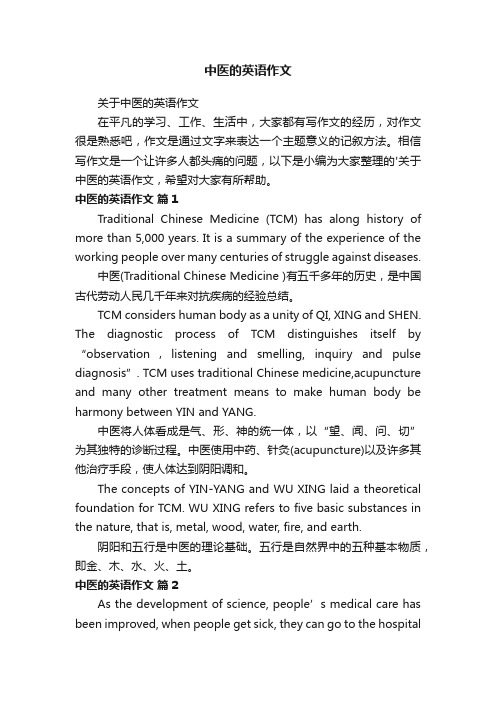
中医的英语作文关于中医的英语作文在平凡的学习、工作、生活中,大家都有写作文的经历,对作文很是熟悉吧,作文是通过文字来表达一个主题意义的记叙方法。
相信写作文是一个让许多人都头痛的问题,以下是小编为大家整理的'关于中医的英语作文,希望对大家有所帮助。
中医的英语作文篇1Traditional Chinese Medicine (TCM) has along history of more than 5,000 years. It is a summary of the experience of the working people over many centuries of struggle against diseases.中医(Traditional Chinese Medicine )有五千多年的历史,是中国古代劳动人民几千年来对抗疾病的经验总结。
TCM considers human body as a unity of QI, XING and SHEN. The diagnostic process of TCM distinguishes itself by “observation,listening and smelling, inquiry and pulse diagnosis”. TCM uses traditional Chinese medicine,acupuncture and many other treatment means to make human body be harmony between YIN and YANG.中医将人体看成是气、形、神的统一体,以“望、闻、问、切”为其独特的诊断过程。
中医使用中药、针灸(acupuncture)以及许多其他治疗手段,使人体达到阴阳调和。
The concepts of YIN-YANG and WU XING laid a theoretical foundation for TCM. WU XING refers to five basic substances in the nature, that is, metal, wood, water, fire, and earth.阴阳和五行是中医的理论基础。
中医药文化英文版
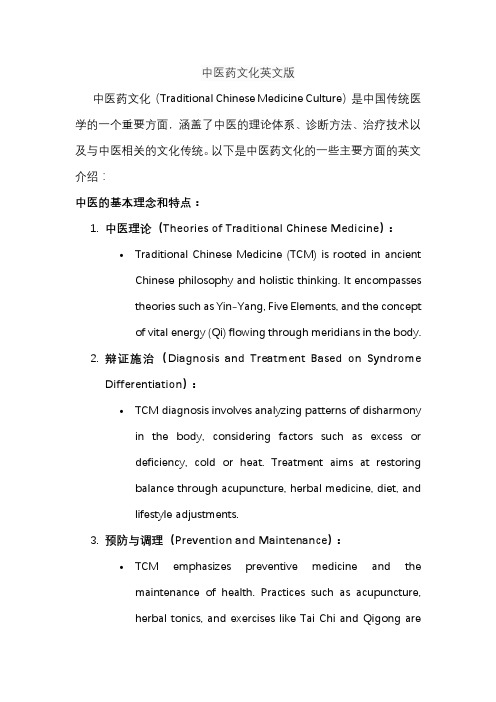
中医药文化英文版中医药文化(Traditional Chinese Medicine Culture)是中国传统医学的一个重要方面,涵盖了中医的理论体系、诊断方法、治疗技术以及与中医相关的文化传统。
以下是中医药文化的一些主要方面的英文介绍:中医的基本理念和特点:1.中医理论(Theories of Traditional Chinese Medicine):•Traditional Chinese Medicine (TCM) is rooted in ancient Chinese philosophy and holistic thinking. It encompassestheories such as Yin-Yang, Five Elements, and the conceptof vital energy (Qi) flowing through meridians in the body.2.辩证施治(Diagnosis and Treatment Based on SyndromeDifferentiation):•TCM diagnosis involves analyzing patterns of disharmony in the body, considering factors such as excess ordeficiency, cold or heat. Treatment aims at restoringbalance through acupuncture, herbal medicine, diet, andlifestyle adjustments.3.预防与调理(Prevention and Maintenance):•TCM emphasizes preventive medicine and the maintenance of health. Practices such as acupuncture,herbal tonics, and exercises like Tai Chi and Qigong areused to strengthen the body's natural defenses.中医的诊断与治疗方法:1.脉诊与舌诊(Pulse and Tongue Diagnosis):•TCM practitioners assess the pulse and examine the tongue to gather information about the patient's internalcondition, including the state of organs and energy flow.2.针灸疗法(Acupuncture):•Acupuncture involves inserting thin needles into specific points on the body to regulate the flow of Qi and restorebalance. It is widely used for pain management andvarious health conditions.3.中药治疗(Herbal Medicine):•Herbal medicine uses a combination of plants, minerals, and animal products to create formulas tailored toindividual patient needs. These formulas aim to addressthe root causes of illnesses.中医文化的历史与发展:1.源远流长(Ancient Roots):•Traditional Chinese Medicine has a history of over 2,500 years. It has evolved through the contributions ofnumerous physicians and scholars, and its theories andpractices continue to be refined.2.现代中医(Modern Developments):•In modern times, TCM has gained recognition worldwide.It integrates with Western medicine in China's healthcaresystem, and acupuncture and herbal medicine arepracticed globally as complementary therapies.3.文化传承(Cultural Heritage):•TCM is not only a system of medicine but also a cultural heritage. It includes practices like Tai Chi and Qigong, aswell as dietary principles based on balance and harmony. 中医文化的影响:1.全球传播(Global Influence):•Traditional Chinese Medicine has gained popularity worldwide, with acupuncture clinics, herbal medicineshops, and TCM wellness practices found in manycountries.2.中医与现代医学的互动(Integration with Modern Medicine):•TCM and Western medicine often complement each other.Many patients seek TCM for chronic conditions, painmanagement, and overall well-being alongsideconventional medical treatments.这些简要的介绍涵盖了中医药文化的一些关键方面。
中医英文介绍

It mainlay study human body’s physiology,pathology, disease diagnosis prevention and cure.
Theoretical Basis
yin-yang(阴阳)
five-elyang Theory
Human body is regarded as an aggregation of essence,energy and spirit.
Five-element Theory
metal----lung wood----liver water---kidney Human body is regarded as an aggregation of
Hua Tuo
the earlist ancestor of surgery
five animals exercise ma fei san
• the herbalist doctor saint(医圣)
Human body is regarded as an aggregation of essence,energy and spirit.
pulse-taking
Methods of Treatment
• Acupuncture(针灸), Moxibustion (艾灸), Herbal medicine(中草药), Nutritional Balance, Massage(按摩), Qi-Gong, Tai Chi , Meditation(冥 想) ……
Chinese Food Therapy
Here is a poem of Chinese Food Therapy:
介绍中医好处英文作文
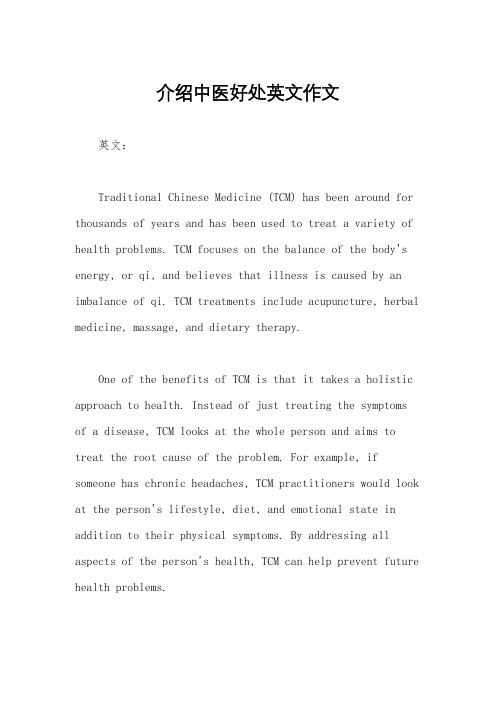
介绍中医好处英文作文英文:Traditional Chinese Medicine (TCM) has been around for thousands of years and has been used to treat a variety of health problems. TCM focuses on the balance of the body's energy, or qi, and believes that illness is caused by an imbalance of qi. TCM treatments include acupuncture, herbal medicine, massage, and dietary therapy.One of the benefits of TCM is that it takes a holistic approach to health. Instead of just treating the symptoms of a disease, TCM looks at the whole person and aims to treat the root cause of the problem. For example, if someone has chronic headaches, TCM practitioners would look at the person's lifestyle, diet, and emotional state in addition to their physical symptoms. By addressing all aspects of the person's health, TCM can help prevent future health problems.Another benefit of TCM is that it is often less invasive than Western medicine. For example, acupuncture uses thin needles to stimulate specific points on the body, which can help relieve pain and promote healing. This is a non-invasive and drug-free treatment option that can be used for a variety of conditions.TCM also emphasizes the importance of prevention. By maintaining a healthy lifestyle and keeping the body in balance, TCM practitioners believe that people can prevent many diseases from developing. This is in contrast to Western medicine, which often focuses on treating diseases after they have already developed.In my personal experience, I have found TCM to be effective in treating a variety of health problems. For example, I have used acupuncture to relieve back pain and herbal medicine to boost my immune system. I appreciate the holistic approach of TCM and the emphasis on prevention.中文:中医已经存在了数千年,并被用于治疗各种健康问题。
中国中医英文介绍
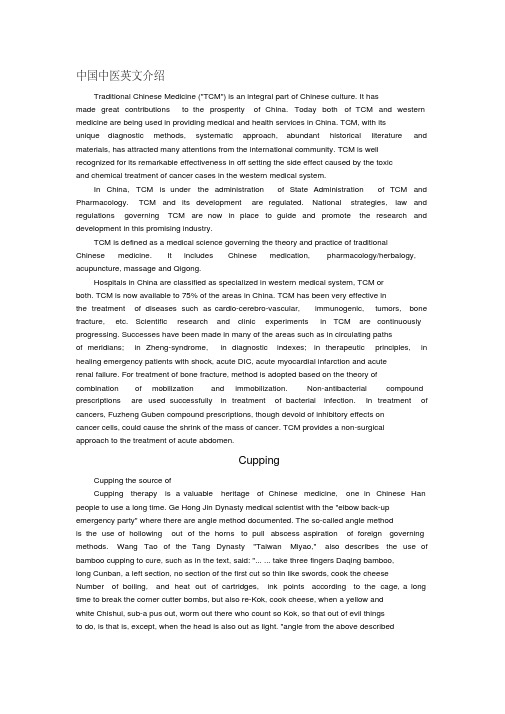
中国中医英文介绍Traditional Chinese Medicine ("TCM") is an integral part of Chinese culture. It hasmade great contributions to the prosperity of China. Today both of TCM and western medicine are being used in providing medical and health services in China. TCM, with itsunique diagnostic methods, systematic approach, abundant historical literature and materials, has attracted many attentions from the international community. TCM is wellrecognized for its remarkable effectiveness in off setting the side effect caused by the toxicand chemical treatment of cancer cases in the western medical system.In China, TCM is under the administration of State Administration of TCM and Pharmacology. TCM and its development are regulated. National strategies, law and regulations governing TCM are now in place to guide and promote the research and development in this promising industry.TCM is defined as a medical science governing the theory and practice of traditionalChinese medicine. It includes Chinese medication, pharmacology/herbalogy, acupuncture, massage and Qigong.Hospitals in China are classified as specialized in western medical system, TCM orboth. TCM is now available to 75% of the areas in China. TCM has been very effective inthe treatment of diseases such as cardio-cerebro-vascular, immunogenic, tumors, bone fracture, etc. Scientific research and clinic experiments in TCM are continuously progressing. Successes have been made in many of the areas such as in circulating pathsof meridians; in Zheng-syndrome, in diagnostic indexes; in therapeutic principles, in healing emergency patients with shock, acute DIC, acute myocardial infarction and acuterenal failure. For treatment of bone fracture, method is adopted based on the theory of combination of mobilization and immobilization. Non-antibacterial compound prescriptions are used successfully in treatment of bacterial infection. In treatment of cancers, Fuzheng Guben compound prescriptions, though devoid of inhibitory effects oncancer cells, could cause the shrink of the mass of cancer. TCM provides a non-surgicalapproach to the treatment of acute abdomen.CuppingCupping the source ofCupping therapy is a valuable heritage of Chinese medicine, one in Chinese Han people to use a long time. Ge Hong Jin Dynasty medical scientist with the "elbow back-up emergency party" where there are angle method documented. The so-called angle methodis the use of hollowing out of the horns to pull abscess aspiration of foreign governing methods. Wang Tao of the Tang Dynasty "Taiwan Miyao," also describes the use of bamboo cupping to cure, such as in the text, said: "... ... take three fingers Daqing bamboo,long Cunban, a left section, no section of the first cut so thin like swords, cook the cheeseNumber of boiling, and heat out of cartridges, ink points according to the cage, a long time to break the corner cutter bombs, but also re-Kok, cook cheese, when a yellow andwhite Chishui, sub-a pus out, worm out there who count so Kok, so that out of evil thingsto do, is that is, except, when the head is also out as light. "angle from the above describedmethod and system of green bamboo cupping of view, China's Jin, Tang Cupping of theera has long been popular.Cupping a comfortable pull Bingti"Cupping" is the private sector is commonly known as cupping therapy, also knownas "pulling pipes" or "suction tube." It is the air tank with heat to exclude the use of negative pressure so that sorption in the skin, causing bleeding as a treatment method ofthe phenomenon. This treatment can be by cold dampness, dredge the meridians, dispelstasis, qi and blood circulation, reduces swelling, pain, diarrhea fever Sida has to adjustthe body's yin and yang balance, lifting of fatigue, enhance physical function to achievethe rousing, cure The purpose of the disease. Therefore, many diseases can be treated with cupping therapy. For example: middle-aged, bones and muscles ache common, according to the interpretation of traditional Chinese medicine mostly rheumatoid Suchis Life. Cupping Guankou cover their time in the affected area, you can slowly suck themoisture out of lesions, while promoting local blood circulation, to relieve pain, restorefunction, and consequently treatment of rheumatism, "Bi Tong" bones bitterness and sodoes not apply.Cupping can do it because of gas-blood circulation, expelling wind and cold-dispelling, reduces swelling, pain, so the back muscle strain, lumbar disc herniationhave a certain therapeutic effect. Dr. Lulu's briefing, fire can also be used in the body acupuncture points, the treatment of headache, dizziness, faces badly bruised, coughing, wheezing, abdominal pain and other illnesses, and more than fire can be implemented atthe same timeCupping Traditional Chinese Medicine on the principle:Chinese medicine, cupping can be opened to vent Cou science, rousing. Disease is caused by pathogenic factors of yin and yang of the body Piansheng partial decline, thebody movements of qi disorders, internal organs caused by blood disorders. When the body is affected by wind, cold, summer heat, wet, dry, fire, poison, trauma or internal injuries invasion blog, you can lead to dysfunctional organs, resulting in pathological product, such as congestion, qi, phlegm, Sushi, water turbid, Xiehuo and so on, these pathological product is pathogenic factors, through the meridians and acupoints to go channeling the body, against the indiscriminate air-stranded organs; deposition resistance in turn, eventually lead to all kinds of illnesses. Cupping resulting vacuum hasa strong pull of the suction force, pulling the suction force acting on the meridian points,it can be to open pores and make skin absorption congestion, so that the body's pathological product from the skin pores to suck out of the body, so that able to dredgethe meridian qi and blood, so that organs function to be adjusted to achieve the purposeof combating the disease. Chinese medicine, cupping can dredge meridians, adjust blood. Meridians have "blood-line, business yin and yang, Confucianism bones, Lee joint," the physiological functions, such as the meridians are not impeded General through the air,blood stagnation line, there may be skin, flesh, tendons, veins and joints dystrophy andatrophy, adverse , or blood do not wing, Six Hollow Organs were not delivered and so on.By cupping the skin, pores, meridians, acupuncture points of the suction pull the role ofanger can lead battalion Wei lost before a cloth, agitation meridians qi, Ru Yang organstissues and organs, very inviting fur, while virtual decline of the organs function to beexcited, smooth meridian, adjust the body's yin and yang balance so that blood can be adjusted so as to achieve fitness illnesses Liaoji purposes.Western medicine on the principle of cuppingModern medicine, cupping treatment tank role in the formation of negative pressure,so that local capillary congestion and even rupture, rupture of red blood cells, skin congestion, there own hemolysis, then produce a histamine histamine and classes of substances, with the body fluids of weeks Stream body, to stimulate the various organs, to enhance its functional activity, can improve the body's resistance. Modern medicine, cupping negative pressure stimulus, enabling the expansion of local blood vessels, promote blood circulation, improve congestive state, strengthen the metabolism, changesin nutritional status of local organizations to enhance the permeability of blood vessel wall and leukocyte phagocytic activity, enhance the body's physical and human immunity.Modern medicine, cupping pressure on local parts of the suction pull, can speed up theblood and lymph circulation, promote gastrointestinal peristalsis, improving digestive function and promote. Speed up the muscle and internal organs on the Elimination of metabolite excretion.Cupping cans left spot, as well as the significance of colorCommon tank spots are flushing, purple or purplish black ecchymosis, small point-like purple rash, but also often accompanied by varying degrees of heat pain. Thesechanges in the skin are cupping therapy effect, and sustainable one to several days.Cupping, the tank spot, such as noticeable blisters, edema, and water vapor-like, indicating that patients with wet wet Sheng or because of the illness experience.Sometimes, after the blisters Secheng drawing blood red or black and red, indicatingthat the wet long illness folder pathological response to stasis.Cans dark red spot appears, Zihei or Dan dehydration phenomena, the micro-touchpain, and those who see the body heat, indicating that patients have a heat-toxin syndrome.Such as cans purple or purplish black spot appears, no Dan stasis and heat phenomena, indicating that there is congestion in patients with disease.Can spot-free skin color changes, do not touch the warm, multi-show patients Deficiency Syndrome.In case of micro-itching spot cans or there Piven, the wind's disease patients had more than that.Generally disease-free more than those who had no significant change in tank spot.About Our Massage ServicesMassage is the practice of soft tissue manipulation. It involves acting on the body and manipulating it with pressure. The masseur may use his hands, fingers, elbows, forearm,and even his feet to manipulate the tissue. Target tissues may include muscles, tendons, ligaments, skin, joints, connective tissue, lymphatic vessels, or organs of thegastrointestinal system. In China, massage is widely practiced and taught in hospitals andmedical schools and is an essential part of primary healthcare.At Sam’s Massage Center, clients lie fully clothed on a massage table. If cupping on scraping treatments are requested, the area to be treated is exposed. Full body oilmassage requires partial disrobing. Blankets are available to keep the client warm shouldthe client feel cold during the massage.Chinese Medical Massage (Tui Na)Chinese Medical Massage is good if you are experiencing pain in one or more parts ofyour body, such as neck pain, lower back pain, shoulder pain, slipped discs, sciatic nervepain, stomach problems (such as indigestion, heartburn, or digestive problems), orintestinal problems. The masseur can give you an all-over massage and focus on specificareas with pain or do a treatment on the affected area. The masseur uses shiatsu, or acupressure, to relieve pain. The masseur may use his thumbs, palms, elbow, and forearmwhile performing the massage.Sam’s Therapeutic MassageSam’s Therapeutic Massage is a deep tissue, all-over body massage. The masseur uses his thumbs to apply pressure to pressure points in the body, then releases his thumb fromthe point. You may experience some pain during the application of pressure, but the endresult is that you will feel relief when the pressure is released.Deep tissue massage is designed to relieve severe tension in the muscles and connective tissue. This type of massage focuses on the muscles located below the surface of the top muscles. Deep tissue massage is recommended for clients who experience constant pain,are involved in heavy physical activity, or have sustained a physical injury.Special Woman’s MassageOur special woman’s massage concentrates on areas of special concern for woman. The massage consists of a medical massage with attention paid to the pelvic area and themuscles above the breasts.Oil MassageWe use aromatic essential oils and massage techniques similar to Swedish massage. Oil massage consists of broad, circular strokes with no pressure point or deep tissue massage techniques. Oil massage is soothing and a great way to feel relaxed and refreshed. We especially recommend oil massage if you have been having difficulty sleeping.Foot MassageOur foot massage is different from traditional Chinese foot massage in that we performthe massage while the client is recumbent. We do not soak the feet in water but apply hot,wet towels to the feet before starting the massage. We use an emollient cream to softenand moisturize the feet during the massage. The masseur uses reflexology techniques to pinpoint problem areas in your body and improve your health.。
中医科普系列英文版
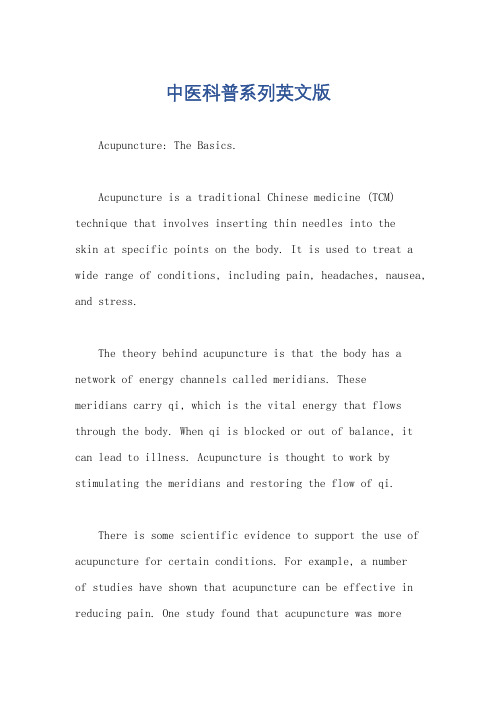
中医科普系列英文版Acupuncture: The Basics.Acupuncture is a traditional Chinese medicine (TCM) technique that involves inserting thin needles into theskin at specific points on the body. It is used to treat a wide range of conditions, including pain, headaches, nausea, and stress.The theory behind acupuncture is that the body has a network of energy channels called meridians. Thesemeridians carry qi, which is the vital energy that flows through the body. When qi is blocked or out of balance, it can lead to illness. Acupuncture is thought to work by stimulating the meridians and restoring the flow of qi.There is some scientific evidence to support the use of acupuncture for certain conditions. For example, a numberof studies have shown that acupuncture can be effective in reducing pain. One study found that acupuncture was moreeffective than sham acupuncture in reducing pain in people with osteoarthritis of the knee.Acupuncture is generally considered to be safe. However, there are some risks associated with the procedure, such as bleeding, bruising, and infection. It is important to see a qualified acupuncturist who is licensed and experienced.How to Prepare for an Acupuncture Treatment.Before your first acupuncture treatment, it isimportant to discuss your health history with your acupuncturist. This will help them to determine whether acupuncture is right for you and to develop a treatment plan.On the day of your treatment, wear loose, comfortable clothing. You will need to lie down on a table during the treatment. The acupuncturist will insert the needles into your skin at specific points on your body. The needles are very thin, so you should not feel any pain.The needles will typically be left in place for 15-30 minutes. During this time, you may feel a sense of relaxation or peace. You may also experience some tingling or numbness around the needles.Once the needles are removed, you may experience some soreness or bruising at the injection sites. This is normal and should go away within a few days.What to Expect After an Acupuncture Treatment.After your acupuncture treatment, you may feel relaxed and refreshed. You may also experience some improvement in your symptoms. However, it is important to be patient, as acupuncture often takes several treatments to work.If you are experiencing any side effects from acupuncture, such as pain, bleeding, or infection, be sure to see your acupuncturist as soon as possible.中文回答:针灸,基础知识。
中医英文介绍作文

中医英文介绍作文英文:As a practitioner of Traditional Chinese Medicine (TCM), I believe that it is important to understand the principles and concepts that underlie this ancient healing art. TCM is a holistic system of medicine that views the body as a complex network of interconnected systems, and seeks to restore balance and harmony to these systems in order to promote health and well-being.One of the key principles of TCM is the concept of Qi (pronounced "chee"), which is often translated as "vital energy" or "life force." Qi flows through the body along a network of channels called meridians, and when this flow is disrupted or blocked, it can lead to illness and disease. TCM treatments such as acupuncture and herbal medicine are designed to restore the flow of Qi and promote healing.Another important principle of TCM is the concept ofYin and Yang, which are two opposing but complementaryforces that exist in all things. Yin represents the passive, feminine, and cooling aspects of nature, while Yang represents the active, masculine, and warming aspects. Inthe body, Yin and Yang must be in balance in order for optimal health to be achieved.In my practice, I often see patients who are struggling with chronic pain, digestive issues, and stress-related conditions such as anxiety and depression. By using TCM treatments such as acupuncture, herbal medicine, anddietary therapy, I am able to address the root causes of these conditions and help my patients achieve lastingrelief and improved health.中文:作为一名中医师,我相信了解中医的原理和概念是非常重要的。
中医入门(中英文)
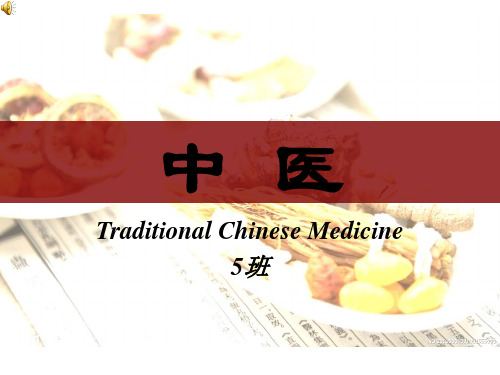
把脉(Feel the Pulse)
VS
• 浮脉(Floating Pulse) • 深脉(Deep Pulse)
问舌(Tongue Check)
• 舌体(Tongue body):
健康(Health)----
嫩红tender red
内寒(Internal cold) ---- 浅红pale red
?????
理念 (Concept)
• 中医的基本理念是身心和谐
The basic theory of Chinese medicine is the harmony between body and mind.
• 防病胜于治疗
Taking good care of one’s body is better than giving medical treatment.
针灸穴位(Acupuncture Points )
迎香穴
Yingxiang Point
驱寒
Prevent cold
人中穴
Renzhong Point
急救
First aid
虎口穴
Hukou Point
牙痛、黑眼圈
Toothache,Black eyes
食疗方法(Dietary Therapy Methods )
• 红枣(Chinese Date) 补血气 Supplementing blood and Qi
• 土豆(Potato) 缓解疼痛 Release pain
• 扁鹊(战国)
Bian Que (Warring Period)
• 望闻问切
Watch,listen,ask,feel
• 华佗(东汉)
Hua Tuo (Donghan Dynasty)
传承中医英语作文
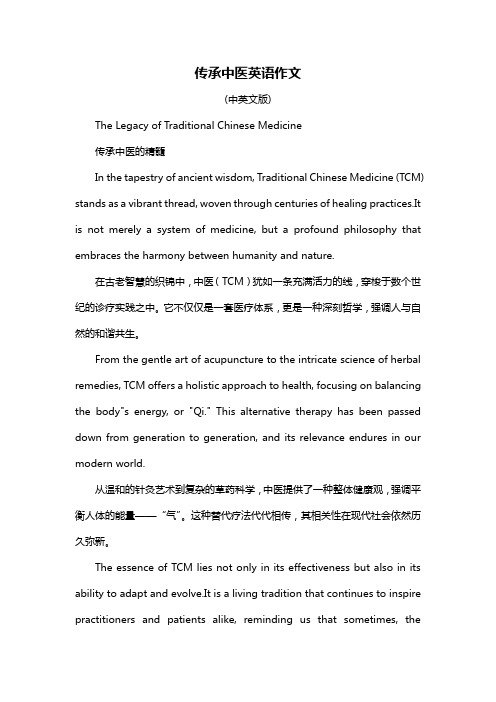
传承中医英语作文(中英文版)The Legacy of Traditional Chinese Medicine传承中医的精髓In the tapestry of ancient wisdom, Traditional Chinese Medicine (TCM) stands as a vibrant thread, woven through centuries of healing practices.It is not merely a system of medicine, but a profound philosophy that embraces the harmony between humanity and nature.在古老智慧的织锦中,中医(TCM)犹如一条充满活力的线,穿梭于数个世纪的诊疗实践之中。
它不仅仅是一套医疗体系,更是一种深刻哲学,强调人与自然的和谐共生。
From the gentle art of acupuncture to the intricate science of herbal remedies, TCM offers a holistic approach to health, focusing on balancing the body"s energy, or "Qi." This alternative therapy has been passed down from generation to generation, and its relevance endures in our modern world.从温和的针灸艺术到复杂的草药科学,中医提供了一种整体健康观,强调平衡人体的能量——“气”。
这种替代疗法代代相传,其相关性在现代社会依然历久弥新。
The essence of TCM lies not only in its effectiveness but also in its ability to adapt and evolve.It is a living tradition that continues to inspire practitioners and patients alike, reminding us that sometimes, theanswers to our health challenges can be found in the wisdom of the past.中医的精髓不仅在于其有效性,还在于其适应和演变的能力。
chinese medicine 中医的简单英文介绍
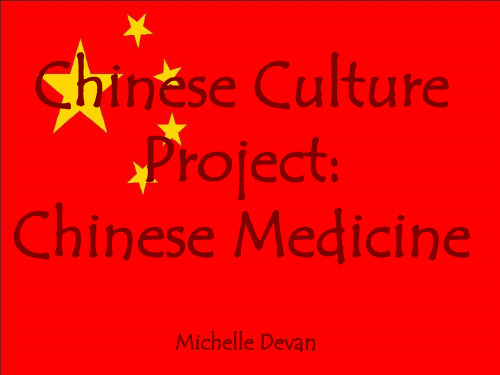
• • • •
Acupuncture
• One of the oldest forms of Chinese Medicine • Acupuncture involves the stimulation of anatomical points on the body with thin needled. • Contrary to what you might think, acupuncture patients usually feel little to no pain. • Acupuncture needles are hairhairthin and are manipulated either by hand or electricity. • Needles are placed at “Yin/Yang Meridian points”
Meditation
• Meditation has been practiced for thousands of years. • It involves focusing on one thing, such as breathing patterns, while clearing all other thoughts from the mind. • Meditation is used to replenish the flow of Qi, which helps to ward off illnesses. • People may experience various feelings during meditation. Some people may begin to feel overjoyed, while others may experience extreme sadness, and even cry. • Meditation is also popularly practiced in western countries as a means of stress relief.
中医演讲稿英文版范文
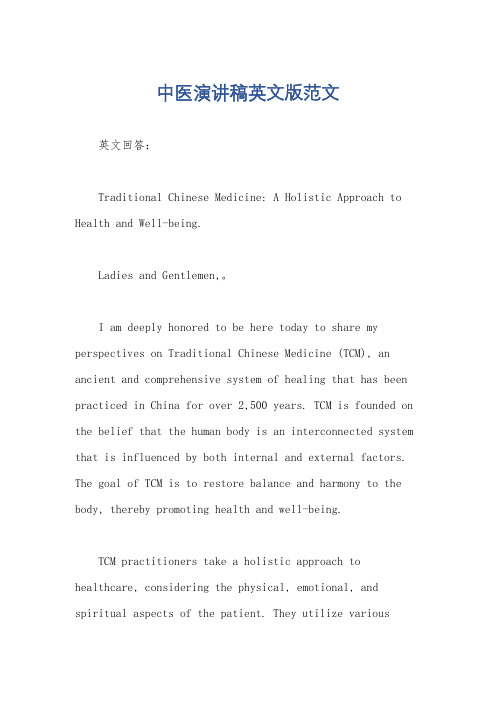
中医演讲稿英文版范文英文回答:Traditional Chinese Medicine: A Holistic Approach to Health and Well-being.Ladies and Gentlemen,。
I am deeply honored to be here today to share my perspectives on Traditional Chinese Medicine (TCM), an ancient and comprehensive system of healing that has been practiced in China for over 2,500 years. TCM is founded on the belief that the human body is an interconnected system that is influenced by both internal and external factors. The goal of TCM is to restore balance and harmony to the body, thereby promoting health and well-being.TCM practitioners take a holistic approach to healthcare, considering the physical, emotional, and spiritual aspects of the patient. They utilize varioustechniques to diagnose and treat illnesses, including acupuncture, herbal medicine, massage therapy, and dietary recommendations.Acupuncture is a technique that involves inserting fine needles into specific points on the body to stimulate the flow of Qi, the vital energy that circulates throughout the body. Acupuncture has been shown to alleviate pain, improve circulation, and boost the immune system.Herbal medicine is another cornerstone of TCM. Practitioners use a wide range of herbs and plant-based remedies to treat various ailments. These herbs have been shown to have anti-inflammatory, antiviral, and antibacterial properties.Massage therapy is also an integral part of TCM. Practitioners use various techniques to manipulate the soft tissues of the body to promote relaxation, relieve tension, and improve circulation.Dietary recommendations play an important role in TCM.Practitioners believe that food has both nutritional and medicinal properties, and they recommend specific dietary plans to support the healing process.TCM has been widely used to treat a variety of health conditions, including:Pain management.Stress and anxiety.Digestive disorders.Respiratory problems.Cardiovascular disease.Neurological disorders.Skin conditions.While TCM is a safe and effective system of healthcare,it is important to consult with a qualified practitioner before starting any treatment. TCM practitioners must undergo rigorous training and are required to meet certain standards to practice.In conclusion, Traditional Chinese Medicine offers a holistic approach to health and well-being that has stood the test of time. By considering the body as a whole and utilizing various techniques to restore balance, TCM practitioners can help alleviate suffering, promote healing, and improve overall well-being.中文回答:中医,一种整体的健康养生之道。
中医英文演讲稿范文
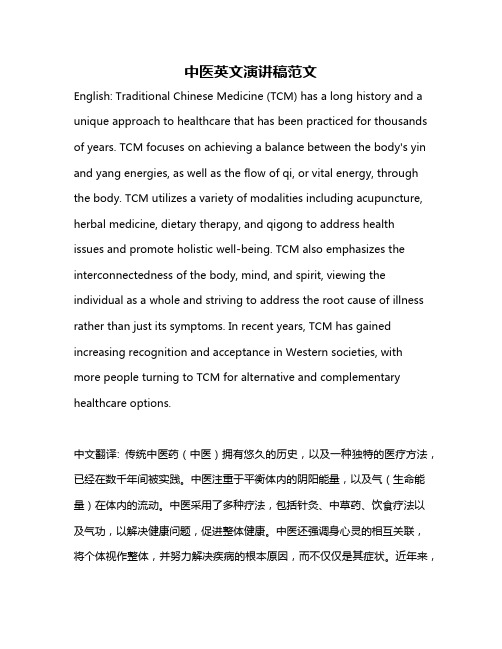
中医英文演讲稿范文English: Traditional Chinese Medicine (TCM) has a long history and a unique approach to healthcare that has been practiced for thousands of years. TCM focuses on achieving a balance between the body's yin and yang energies, as well as the flow of qi, or vital energy, through the body. TCM utilizes a variety of modalities including acupuncture, herbal medicine, dietary therapy, and qigong to address health issues and promote holistic well-being. TCM also emphasizes the interconnectedness of the body, mind, and spirit, viewing the individual as a whole and striving to address the root cause of illness rather than just its symptoms. In recent years, TCM has gained increasing recognition and acceptance in Western societies, with more people turning to TCM for alternative and complementary healthcare options.中文翻译: 传统中医药(中医)拥有悠久的历史,以及一种独特的医疗方法,已经在数千年间被实践。
介绍中医作文英文

介绍中医作文英文Traditional Chinese Medicine (TCM) is a comprehensive system of healthcare that has been practiced for thousands of years in China. It encompasses various forms of herbal medicine, acupuncture, massage, and dietary therapy, all of which are based on the concept of balancing the body's energy, or qi.One of the fundamental principles of TCM is the idea that the body's vital energy, or qi, flows through meridians, or pathways, in the body. When the flow of qi is disrupted, illness and disease can occur. TCM treatments aim to restore the balance and flow of qi in the body, thereby promoting health and well-being.Herbal medicine is a key component of TCM, with a wide range of herbs used to treat different ailments and promote overall health. These herbs are often combined into formulas that are tailored to each individual's specific needs and constitution.Acupuncture is another important aspect of TCM, involving the insertion of thin needles into specific points on the body to stimulate the flow of qi and promote healing. It is commonly used to relieve pain, treat chronic conditions, and improve overall health.In addition to herbal medicine and acupuncture, TCM also emphasizes the importance of lifestyle and dietary choices in maintaining health. Dietary therapy in TCM focuses on the idea of food as medicine, with specific foods and cooking methods used to address imbalances in the body.TCM is based on the concept of holism, viewing the body as a whole and emphasizing the interconnectedness of the mind, body, and spirit. This holistic approach to health and wellness sets TCM apart from Western medicine, which tends to focus on treating specific symptoms or diseases.Overall, TCM offers a unique and comprehensive approach to healthcare, with its focus on balancing the body'senergy, using natural remedies, and promoting overall well-being. Its long history and continued popularity in China and around the world are a testament to its effectiveness and enduring appeal.。
中医中药英文演讲稿范文

Ladies and gentlemen,Good morning/afternoon/evening. It is my great honor to stand before you today and share with you the fascinating world of Traditional Chinese Medicine (TCM) and its precious herbs. TCM, as an ancient and holistic system of medicine, has been practiced in China for over 5,000 years. It has played a significant role in the health and well-being of millionsof people. In this speech, I will introduce the basic principles of TCM, its diagnostic methods, and the wonders of Chinese herbs.I. Introduction to Traditional Chinese Medicine1. Definition and historyTraditional Chinese Medicine is a comprehensive medical system that combines natural therapies, herbal medicine, acupuncture, and other methods to promote health and treat diseases. It originated in ancient China and has been passed down from generation to generation. TCM is based on the theory of Yin and Yang, the concept of five elements, and the understanding of the human body's internal and external environments.2. Principles of TCMThe core principles of TCM include:(1) The theory of Yin and Yang: TCM holds that the universe and the human body are composed of two opposing forces, Yin (cool, slow, passive) and Yang (hot, active, dynamic). Health is achieved when these twoforces are in balance.(2) The concept of five elements: Wood, fire, earth, metal, and waterare the five fundamental elements that make up the world and the human body. TCM believes that the five elements are interconnected and can influence each other, thus affecting the health of a person.(3) The understanding of the internal and external environments: TCM emphasizes the importance of maintaining a harmonious relationship between the body's internal organs and the external environment,including the climate, diet, and emotions.II. Diagnostic Methods in TCMTCM uses a variety of diagnostic methods to identify the root cause of a disease. The most common diagnostic methods include:1. Inspection: Observing the patient's appearance, tongue, and nails.2. Auscultation: Listening to the patient's voice, breathing, and heartbeat.3. Olfaction: Smelling the patient's breath, body odor, and secretions.4. Palpation: Feeling the patient's pulse, abdomen, and other parts of the body.5. Inquiry: Asking the patient about their symptoms, medical history, and lifestyle.III. The Wonders of Chinese HerbsChinese herbs are the backbone of TCM. They are natural substances that have been used for thousands of years to treat various diseases. Here are some of the wonders of Chinese herbs:1. Diversity: There are over 13,000 kinds of Chinese herbs, each with unique properties and functions.2. Combination: TCM often uses herbal formulas, which are combinations of multiple herbs that work together to treat specific diseases.3. Safety: Chinese herbs are generally safe when used properly. However, it is important to consult a qualified TCM practitioner before taking any herbal remedies.4. Efficacy: Many Chinese herbs have been proven to be effective in treating various diseases, such as diabetes, hypertension, and cancer.5. Integration with modern medicine: TCM and modern medicine can be integrated to enhance the efficacy of treatment and reduce side effects.IV. The Importance of TCM and Chinese Herbs1. Promoting health and preventing diseasesTCM can help maintain a healthy lifestyle and prevent diseases by balancing the body's Yin and Yang, regulating the five elements, and improving the immune system.2. Treating chronic diseasesTCM has proven to be effective in treating chronic diseases, such as arthritis, asthma, and kidney disease.3. Complementary therapyTCM can be used as a complementary therapy to modern medicine, reducing side effects and improving the quality of life for patients.4. Cultural heritageTCM and Chinese herbs are an important part of Chinese culture and heritage. They represent the wisdom and experience of our ancestors.V. ConclusionIn conclusion, Traditional Chinese Medicine and its precious herbs have been a treasure trove of knowledge for thousands of years. With the advancement of modern science and technology, TCM has gained international recognition and has become an important part of the global healthcare system. I believe that by exploring and promoting TCM, we can achieve a better understanding of the human body and improve the quality of life for people around the world.Thank you for your attention. I hope that this speech has provided you with a glimpse into the marvels of Traditional Chinese Medicine and its precious herbs.。
中医英文作文素材
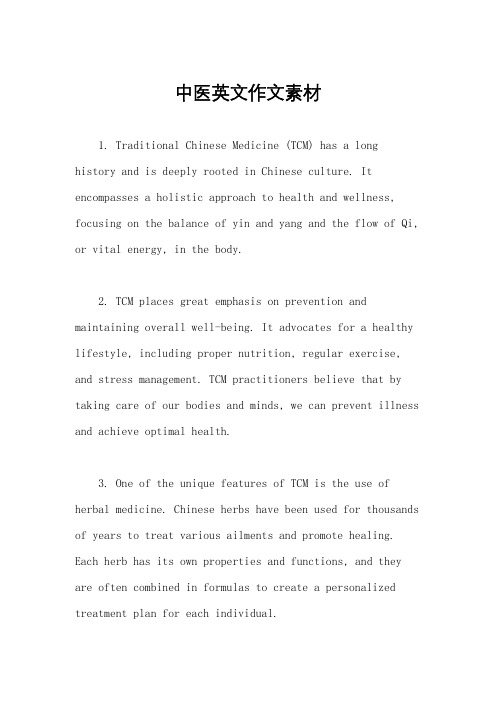
中医英文作文素材1. Traditional Chinese Medicine (TCM) has a longhistory and is deeply rooted in Chinese culture. It encompasses a holistic approach to health and wellness, focusing on the balance of yin and yang and the flow of Qi, or vital energy, in the body.2. TCM places great emphasis on prevention and maintaining overall well-being. It advocates for a healthy lifestyle, including proper nutrition, regular exercise, and stress management. TCM practitioners believe that by taking care of our bodies and minds, we can prevent illness and achieve optimal health.3. One of the unique features of TCM is the use of herbal medicine. Chinese herbs have been used for thousands of years to treat various ailments and promote healing. Each herb has its own properties and functions, and they are often combined in formulas to create a personalized treatment plan for each individual.4. Acupuncture is another popular treatment modality in TCM. It involves the insertion of thin needles intospecific points on the body to stimulate the flow of Qi and restore balance. Acupuncture is often used to relieve pain, reduce inflammation, and improve overall well-being.5. TCM also includes other techniques such as cupping, moxibustion, and Tui Na massage. Cupping involves placing heated glass cups on the skin to create a suction effect, which helps to improve blood circulation and relieve muscle tension. Moxibustion uses the burning of dried mugwort to warm and stimulate acupuncture points. Tui Na massage involves applying pressure and manipulation techniques to the body to promote healing and relaxation.6. TCM is gaining popularity worldwide as people seek alternative and complementary approaches to healthcare. Many Western medical practitioners are now incorporating TCM techniques into their practices, recognizing the benefits of a holistic approach to health.7. However, it is important to note that TCM is not a substitute for Western medicine. It should be used as a complementary therapy alongside conventional treatments. It is always advisable to consult with a qualified TCM practitioner or healthcare professional before starting any TCM treatment.8. In conclusion, TCM offers a unique and holistic approach to health and wellness. Its emphasis on prevention, personalized treatment, and natural remedies make it a valuable addition to the healthcare system. Whether used as a primary or complementary therapy, TCM can helpindividuals achieve and maintain optimal health.。
中药介绍作文英文
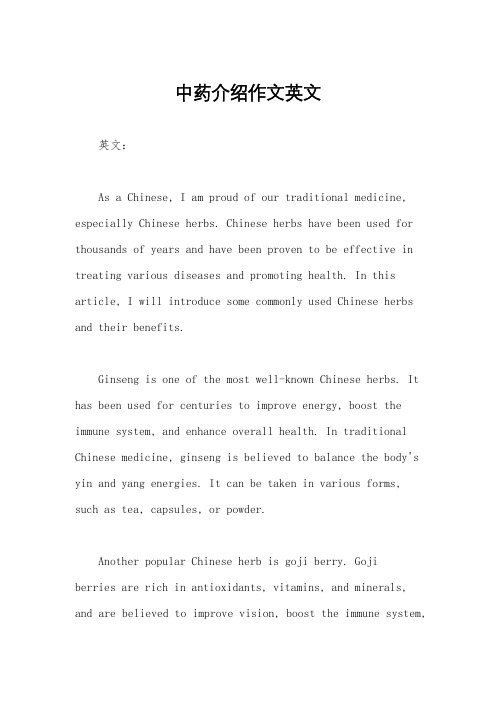
中药介绍作文英文英文:As a Chinese, I am proud of our traditional medicine, especially Chinese herbs. Chinese herbs have been used for thousands of years and have been proven to be effective in treating various diseases and promoting health. In this article, I will introduce some commonly used Chinese herbs and their benefits.Ginseng is one of the most well-known Chinese herbs. It has been used for centuries to improve energy, boost the immune system, and enhance overall health. In traditional Chinese medicine, ginseng is believed to balance the body's yin and yang energies. It can be taken in various forms, such as tea, capsules, or powder.Another popular Chinese herb is goji berry. Gojiberries are rich in antioxidants, vitamins, and minerals, and are believed to improve vision, boost the immune system,and promote longevity. They can be eaten raw, dried, or in the form of juice.Astragalus root is also commonly used in Chinese medicine. It is believed to enhance the immune system, reduce inflammation, and improve heart health. It can be taken in the form of tea, capsules, or powder.In addition to these herbs, there are many other Chinese herbs that are used for various purposes, such as treating insomnia, promoting digestion, and reducing stress. Chinese medicine is based on the concept of treating the whole person, not just the symptoms, and therefore, it may take longer to see results compared to Western medicine. However, many people have found Chinese medicine to be effective in improving their overall health and well-being.中文:作为一个中国人,我为我们的传统医学,特别是中药感到自豪。
中医英文介绍

中医英文介绍Traditional Chinese Medicine (TCM) is a holistic healthcare system that has been practiced for thousands of years in China and is gaining popularity worldwide. It is based on the concept of balance and harmony within the body, where illness is seen as an imbalance or disruption in this harmony.TCM includes various modalities such as acupuncture, herbal medicine, tui na (therapeutic massage), cupping, and dietary therapy. Acupuncture involves the insertion of thin needles into specific points on the body to stimulate energy flow and restore balance. Herbal medicine uses natural substances, such as plants, minerals, and animal products, to treat various conditions and support overall health. Tui na uses manual techniques to manipulate the body's energy channels and promote healing. Cupping involves placing heatedcups on the skin to create suction and improve circulation. Dietary therapy focuses on using specific foods and herbs to maintain health and treat various conditions.TCM views the body as an interconnected system, where each organ and meridian (energy pathway) plays a vital role in maintaining balance. It emphasizes the concept of yin and yang, representing opposing but complementary forces in the body that must be in balance for optimal health. TCM practitioners assess patients' overall health and identify patterns of disharmony through various diagnostic methods, such as pulse and tongue examination.One of the key principles of TCM is the prevention of disease, where maintaining balance and harmony within the body is emphasized. TCM can be used to treat a wide range of conditions, including pain, digestive issues, respiratory disorders, hormonal imbalances, and mental health disorders. It is known for its ability to address both acute and chronicconditions and is often used as a complementary therapy alongside Western medicine.Overall, TCM offers a unique approach to healthcare, focusing on the individual as a whole and promoting a balance of mind, body, and spirit. With its long history and growing scientific evidence supporting its efficacy, TCM continues to gain recognition as a valuable healthcare system worldwide.。
- 1、下载文档前请自行甄别文档内容的完整性,平台不提供额外的编辑、内容补充、找答案等附加服务。
- 2、"仅部分预览"的文档,不可在线预览部分如存在完整性等问题,可反馈申请退款(可完整预览的文档不适用该条件!)。
- 3、如文档侵犯您的权益,请联系客服反馈,我们会尽快为您处理(人工客服工作时间:9:00-18:30)。
Traditional Chinese medicine (also known as TCM, simplified Chinese: 中医; traditional Chinese: 中医; pinyin: zhōngyī) includes a range of traditional medical practices originating in China. It is considered a Complementary or Alternative Medical system in much of the western world while remaining as a form of primary care throughout most of Asia.TCM practices include treatments such as herbal medicine, acupuncture, dietary therapy, Tui na and Shiatsu massage; often Qigong and Taiji are also strongly affiliated with TCM.TCM theory is extremely complex and originated thousands of years ago through meticulous observation of nature, the cosmos, and the human body. Major theories include those of Yin-yang, the Five Phases, the human body Channel system, Zang Fu organ theory, six confirmations, four layers, etc.0 RADITIONAL- CHINESE MEDICINE WITH A LONG HISTORY历史悠久的中国传统医学Traditional Chinese medicine ( TCM)has a history of several years. Its origin can be traced back to remote antiquity.In a long course of struggling against diseases, TCM evolved into a unique and integrated theoretical systcm of TCM. It is an important part of Chinese culture. More than 2,000 years ago, came out Huangdi's Classic on Medicine( Huang Di Nei jing ), which is the earliest medical classic extant in China. It consists of two parts—Basic Questions ( Su Wen ) and Miraculous Pivot( Ling Shu ), each comprising) nine volumes, each of which, in turn, contains nine chapters, totaling up to 162 chapters.The book gives a complete and systematic exposition to the following various subjects : the relationship between man and nature, the physiology and pathology of the human body, and the diagnosis, treatment and prevention ot diseases. It also uses the theories of yin-yang and the five elements to deal fully with the principles of treatment by 中医有着几千年的历史,起源可追溯至远古时代。
在长期与疾病的斗争中,中医演化并形成了一套独特且完整的理论体系。
2000多年前出现的《黄帝内经》是中国现存的最早医著。
它由《素问》和《灵枢》两部分组成。
每部分包含9卷,每卷又有9章,总计162章。
该书对人和自然的关系、人体的生理及病理、疾病的预防和诊治等方面进行了系统全面的说明。
同时它运用阴阳和五行理论全面阐述了因时、因地、因人而异辩证论治的原则并且表达了整体观念的思想即把人体看作一个整体,把人与其周围的环境看作一个整体。
这为中医理论的形成奠定了初步的基础。
继《黄帝内经》之后,东汉时期之前出现了《难经》。
该书涉及了中医的基础理论如生理、病理和疾病的诊治等。
它补充了《黄帝内经》的不足。
自此许多不同的学派及经典著作相继出现,各抒己见。
differentiation of syndromes (TDS) according to the climatic and seasonal conditions, geographical localities and individual constitution. Hence( giving expression) to the holistic concept of taking the human body as an organic whole and taking the human body with the surrounding environment as the integrity. It laid a preliminary foundation for the theoretical formation of TCM. After Huangdi's Classic on Medicine another classic of medicine, Classic on Medical Problems ( Nan Jing ), was given birth to the world before the Eastern Han Dynasty. The book deals mainly with the basic theory of TCM, such as physiology, pathology, diagnosis and treatment of diseases and so on. It supplemented what Huangdi's Classic on Medicine lacked. From then on, many medical schools and various classics on medicine were brought into being in succession, each having its own strong points.Shen Nong's Herbal ( Shen Nong Ben Cao Jing ), also known as Classic on the Herbal (Ben Cao Jing ) or The Herbal ( Ben Cao ), is the earliest book on materiamedica in China, which appeared in about the Qin-Han Period with its authorship unknown. Not only does it list 365 medicinal item —among which 252 areherbs, 67 are animals, and 46 are minerals, but also divides them into three grades according to their different properties and effects. The book also gives a brief account of pharmacological theories—principal (jun ), adjuvant (chen ), assistant ( zuo ) and guide (shi ); harmony in seven emotions ( qi qing he he ), four properties of medicinal herbs ( si qi ) and five tastes of medicinal herbs ( wu wei ). 《神农本草》(亦称“本草经”或“本草”)是中国最早的药物学专著。
它出现于秦汉时期,作者不祥。
它不仅罗列了365种药物(其中草药252种,动物类药67种,矿物类药46种)而且依药物性质及功效的不同将其分为三个等级。
同时,该书简述了方剂的基本原则(君、臣、佐、使)和七情与药物的四气五味相和的原则。
In the Han Dynasty (3rd century 汉朝(公元前3世纪)的张AD ), Zhang Zhongjing, an outstanding physician, wrote Treatise on Febrile and Miscellaneous Diseases ( Shang Han Za Bing Lun ), which is divided into two books by later generations, one is entitled " Treatise onFebrile Diseases", ( Shang Han Lun ) , the other Synopsis ofPrescriptions of Golden Cabinet (Jin KuiYao Lue ) . The book established thepnriciple of TDS (Treatment ofDifferentiation Syndromes ;TechnicalData System 技术数据系统), therebylaying a foundation for the developmentof clinical medicine.仲景是一位著名的医家,著有《伤寒杂病论》。
